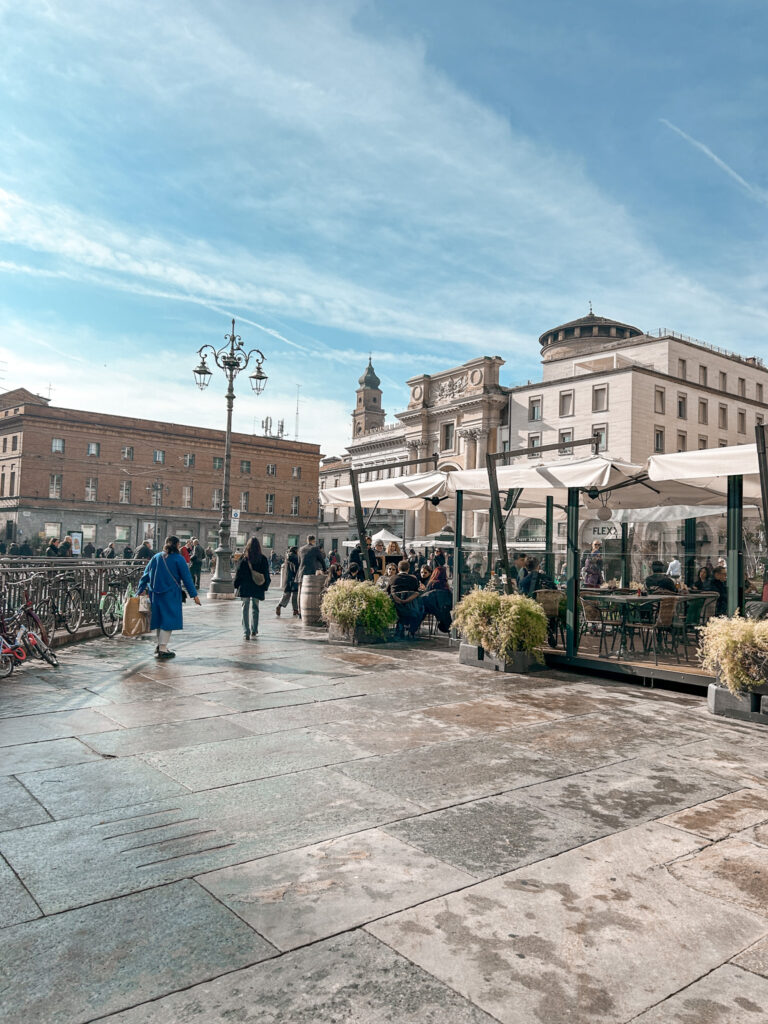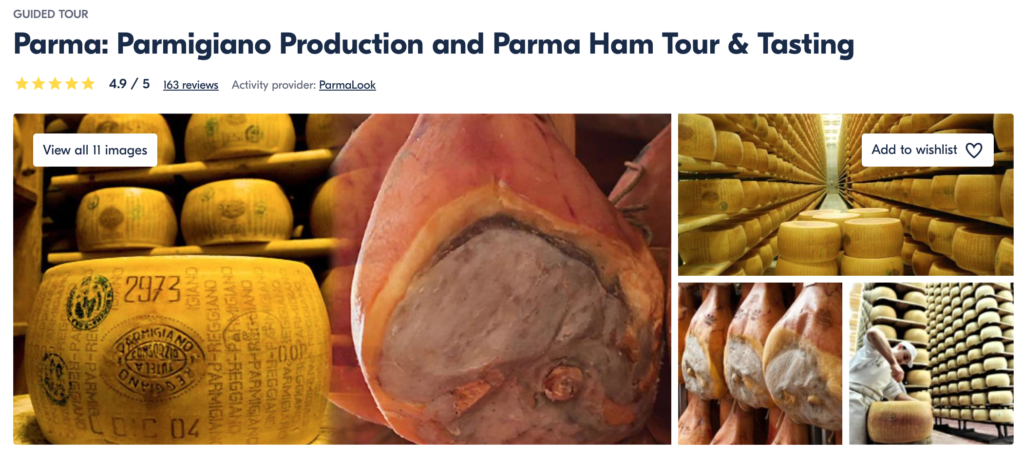
Parma is a city in central Italy, famous particularly for the Parmesan cheese and Parma ham. But Parma is not just the European culinary capital. It is a colourful city full of art, renaissance buildings, and green parks, full of happy people living a relaxed Italian lifestyle.
Read further to discover what to see in Parma, where to eat the best prosciutto, and have a delicious parmesan cheese-tasting.
Note: this post includes affiliate links. I gain a small commission from the provider each time you click the link and book a service through it. That comes at no extra cost to you. Every little commission helps me run this blog and provide better content for you.
Parma - The land of cheese
Walking around the town we stumbled across an amazing saying by Thomas Gray, calling Parma “The happy country where huge cheeses grow.”
Parma is famous for no other but parmesan cheese and prosciutto di Parma and is a popular choice for all fans of good food.
How to reach Parma?
Parma has its train station so if you do not own a car, my recommendation is to hop on a train. The city is well connected no matter which side of Italy you arrive from (we arrived from Milan).
For all of you traveling from Milan: The fastest and cheapest way is to take the Intercity train from either Milano Porta Garibaldi or Milano Centrale. The trip takes around 1.5 – 2 hours, the duration depends on your departure station. We got our return tickets for only 20eur per person.
Where to stay in Parma?
Parma is small and easy to navigate. I would recommend two locations when choosing your stay:
- the strict city center or
- the area east of the train station
Staying in the city center needs no introduction. You hop from your hotel directly to the hustle and bustle of Italian life. Here you will find countless cafés, bars, and restaurants and truly experience the vibe of the city.
Staying by the train station, instead, gives you the advantage of reaching your train in a matter of minutes. And you are only 10 minutes away from the strict center. If you don’t mind a short walk, I would recommend you stay closer to the train station. The accommodation there is cheaper. Plus, no dragging your suitcases on the cobblestone-paved streets.
As a heads up, you can expect to pay between 70-100eur per night for 2 people, excluding breakfast. The price is for outside the main season.
We stayed in Parma overnight and booked our stay with Novotel Parma Centro. Novotel offered the most comfortable and modern stay at a reasonable price. We ended up enjoying the stay, the room was spotlessly cleaned, the service excellent and the staff incredibly friendly. 10/10. 💎
How safe is Parma?
I expected Parma to be a safe city. After visiting, I can say that Parma is generally safe to walk around during the day. My feeling at night, however, was different. I would not recommend walking around Parma at night alone. The areas to avoid are the train station and the area across the river (the side of Parco Ducale), the latest noted as an unsafe area by friends living in the city.
What to see in Parma?
Based on my experience, Parma is best experienced in one day or a weekend. The city is small and walkable, so you don’t need to worry about public transport. To paint a picture, the furthest attraction (Cittadella Park) is about a 15-minute walk from the center only!
Let’s take a closer look at what to see in Parma in a day or two.
1. Piazza del Duomo - Cattedrale di Parma & Battistero di Parma
Starting our tour of Parma at the main square of the city – Piazza del Duomo. This picturesque traditionally Italian square features Parma’s main cathedral (Cattedrale di Parma) and the Baptistery of Parma (Battistero di Parma).
Battistero di Parma is one of the most important European medieval monuments, coated in fine pink marble. It is famous for its octagonal design and unique interior, namely the painted high ceiling. Whereas the tickets to the baptistery cost 12eur, the entrance to the Cathedral is free.


Piazza del Duomo Parma
YOU MIGHT ENJOY: 12 OTHER IDEAS FOR DAILY TRIPS FROM MILAN
2. Piazza Giuseppe Garibaldi
Next up is Piazza Giuseppe Garibaldi, named after the Italian revolutionary who contributed to unifying Italy back in the day. Today, the square is famous for its countless bars and cafes and a popular spot for lunch or aperitivo.


Piazza Garibaldi and Aperitivo on Piazza Garibaldi with parmigiano tasting
3. Palazzo della Pilotta & Piazza della Pace
Palazzo della Pilota is in my opinion one of the most magnificent buildings in Parma. It’s located in the strict city center but its dimensions are gigantic. Once a palace, today a cultural building, Palazzo della Pilota hosts a good number of cultural institutions and museums:
- Parma National Gallery
- National Archeological Museum
- An entire Art School
- A thearer – Teatro Farnese
- Museo Bodoniano
There is a lively farmers market at Piazza della Pace every Wednesday and Saturday, between 7 am and 2 pm.


Palazzo della Pilota and Piazza della Pace with Saturday Market
4. Parco Ducale & Cittadella Park
Parco Ducale is a public park with a free entrance on the other side of River Parma, just a short walk away from the city center. Just south of the city center is another park – Cittadella Park, a popular walking and jogging spot. Parco Cittadella is famous for its pentagon shape and was once a fortress.

Parco Ducale
5. Taste traditional Parma dishes
It is a deal breaker saying you visited Parma without tasting some of the traditional Parma dishes. Prosciutto di Parma tagliere and Parmigiano Reggiano tastings are a must. Toretlli and Torta Fritta are just as obligatory!
Here is a list of traditional restaurants where to eat traditional dishes:
- Trattoria Corrieri – historic trattoria from the 1800s serving handmade pasta and meat dishes; if you do not have a reservation you will need to queue for a bit
- Ristorante La Forchetta
- Officina Alimentare Dedicata Parma
- Antica Osteria della Ghiaia


Lunch at Trattoria Corrieri – Tagliere & Torta Fritta (left), Tortelli di Zucca (right)
6. Visit Mercato coperto Ghiaia
You will find Mercato Ghiaia on a town square by the river. The beginnings of Piazza Ghiaia’s traditional covered market date back to the 13th century. You can buy everything on Mercato Ghiaia – from clothes to shoes, basic home appliances, cleaning supplies, and antiquities.
Mercato Ghiaia is open on Tuesdays, Wednesdays, Saturdays, and Sundays – either during the mornings or for the entire day.
If I had to sum up my Parma, I would call it a sunny and friendly city with endless food choices. And now it’s your turn to visit Parma and explore it on your own. I hope this short guide comes in handy while planning your trip to Parma. Happy traveling!
Like it? Why not pin it for later

Hi, it's Neja
I am an expat from Slovenia,
living in Milan since 2021 and writing a travel blog for all of you who are curious about life in Italy or traveling in Europe.
Follow me on my journey and learn everything about Italy and the European destinations.








